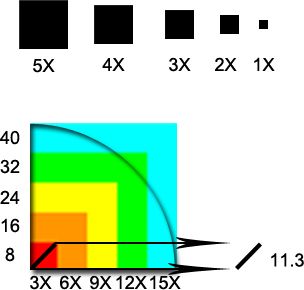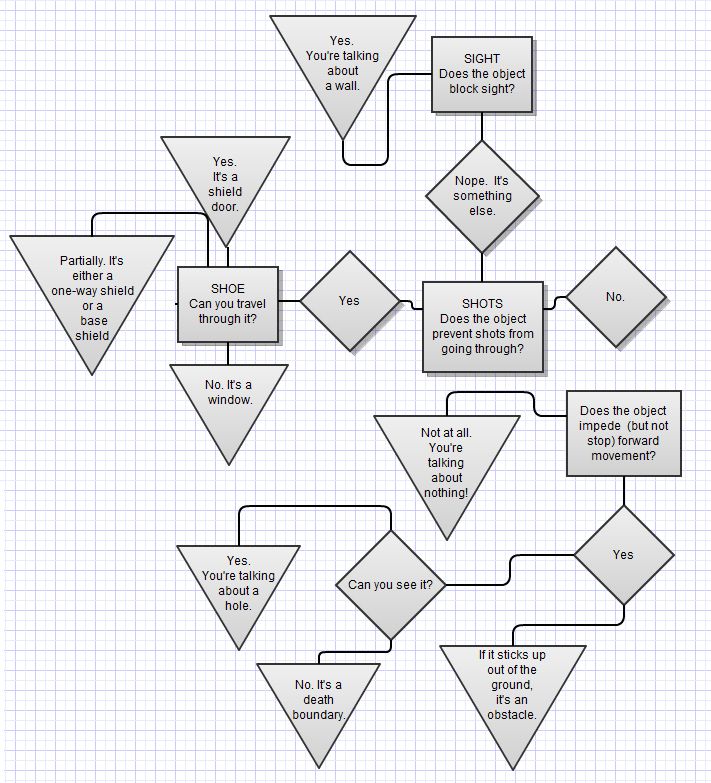This thread contains tips that you can use to build your own CQC map. I'm not one in the way of creativity or vision, but I can impart what knowledge I have so far as to how CQC works. We'll be taking a look into specific game mechanics and theories that will be applied to CQC.
SECTIONS:[1.] What is CQC?
[2.] Making sense of distance
[3.] Radar Influences
[4.] Object Qualities
[5.] Conclusion
SECTION [1.] - What is CQC?
CQC is an abbreviation for "Close Quarters Combat". Such a term is used in various defense organizations around the world. And if you're reading this, you're probably thinking about video games instead. Although arbitrary, the designation of "close" means that you're looking from point-blank to a range well below that of the maximum range of combat that is being referenced.
Of course, since every video game is different, CQC can take on different meanings. In Halo (and more particularly Halo 4) we're referring to where all weapons intended for more proximal ranges can be effective. As every weapon is effective point-blank, the number 0 will be our constant. Therefore, we can focus on what ranges the weapons become ineffective.
For simplicity's sake, we're going to say that all precision weapons have a range of infinity, and won't be accounted for in the process of determining what is close-quarters. That leaves us with fully-automatic weapons, shotguns, explosives, and melee weapons as being up to question. Since explosives can detonate upon any range, melee weapons are point-blank, and shotguns are obviously ineffective at a distance, that leaves us with the automatics:
- Suppressor ~ 10 meters
- Storm Rifle - inferior to Assault Rifle
- Assault Rifle ~ 20 meters
- Needler - ineffective at 80 meters, velocity of 40 m/s
- SAW ~ 30 meters
SECTION [2.] - Making sense of distance
I can tell you what x amount of meters is, but that doesn't mean you can hop into Forge and have a precise idea (if any) what I'm talking about. I'll explain how you can find true distances, and how the distances apply to specific piece dimensions in Forge.
Let's play out this scenario. You and I are standing directly across from each other in Halo 4. With your Binoculars (aim button with a non-ADS weapon), you get a reading of 10 meters away. Now you walk as close as physically possible to me. The Binoculars should say 0 meters, right? Unfortunately, they don't. The closest reading you'll ever get is something along the lines of 2.07 meters. For an actual distance, you know it should be 0. Follow this equation:
Actual distance = Binocular distance - 2
But that still doesn't solve what we can use meters for in relation to pieces. The same test that was done above was actually conducted on a piece that was "3x" long (following the pieces in the "Building Blocks" category). The following picture explains what ranges are associated with different numbered dimensions:

The vertical axis displays the distances in meters, and the horizontal with the block dimensions. Although there aren't any 9x9 blocks, for example, this is to demonstrate what you could create. If you take the diagonal section of each 3x3 block, you'd see it comes to around 11.3 meters.
What is the circle, you might ask? Yeah, that's the radar...
SECTION [3.] - Radar Influences
I cannot state this enough, and you can see it yourself. Radar is one of the main causes of crappy CQC in Halo 4. Let's examine what's up, and see how we can fix it.
Many people are still under the presumption that radar is still 25 meters in radius. Here's the specifics of the actual radar for Infinity Slayer:
- Horizontal Range: Circle with 40 meter radius (yeah, 40!)
- Vertical Range: Infinite, for all practical uses
- Detects: Enemies that are moving
An easy way to fix this problem, regardless of gametype, is to put a Trait Zone around your entire map. The 25-meter range is the only other option below 40 (unless you combine zones, but that's a different story), and I think that it's the best for CQC. Non-moving enemies on radar could be put to detectable if you have issues with the camping. As far as the height is concerned, multi-level mapping is a great way to confuse your enemy into thinking someone is present where they really aren't. This makes the radar less reliable overall, which is good if you're talking about skilled CQC action.
Or, you could go the easy route and apply the above changes to your own CQC gametype. Up to you.
SECTION [4.] - Object Qualities
Halo presents us with a lot of diverse objects to create maps with compared to other games. I'll explain how to sort through the properties of these pieces, and which ones will be conducive to CQC.
To explain what qualities these objects have, I've taken the liberty into making a pretty picture and flow chart.


Hopefully that makes sense to you. It's really not THAT complicated. Applying it is where combat expertise comes in.
SIGHT: Sight blockers are critical to create a CQC map. The space should not have long corridors or a huge field of vision. Going by the ranges of CQC areas, you should feel pretty cramped. To compensate for the lack of vast space, you should look into replicating the basic structure of these areas and add your own spice to the space.
SHOT: Although they're novelties, shot-not-sight blockers can be fun and effective. Guarding a one-way shield or peeping at oncoming enemies through a window will compensate for your lack of radar and make combat more vision-based.
SHOE: It's pretty self-explanatory, but important - try to make Shoe-only blockers that don't restrict Sight or Shot. The main reason for this is your classic Halo one-two punch. Melee can ruin CQC and make it bland. To offset this, put some obstacles in the way of such assailants so that they need to either use their gun or flank around. If you're planning on making holes in windows and objects to allow for gunfire to pass through, make sure the object cannot be jumped through easily or can be hid behind. It goes back to the first sentence, but failure to see this through will result in a lot of sketchy situations. On the flip side, accomplishing all of these correctly can really help your maps become dynamic and interesting.
SECTION [5.] - Conclusion
CQC is not inertly easy in Halo 4. We've defined that the range you're looking at is somewhere between 0-25 meters, based on the weapons you can use in those circumstances. Distance is a critical part of CQC map design. Using building blocks and the guide above, you can accurately determine how long your pieces are based on Forge dimensions. Radar is another killer of CQC. With the right adjustments, you can limit the effectiveness of the radar to make it easier on these regions where it would otherwise be unfair. Finally, objects in Halo 4 have special qualities that fall under the "Sight, Shot, Shoe" subcategories. Knowing the properties of the objects in the map you design will aid in balance, and create an enjoyable atmosphere for CQC players.
With this knowledge, I hope to see your creativity and vision shine through into some great Halo 4 CQC maps! Thanks for reading. Have a good one.












